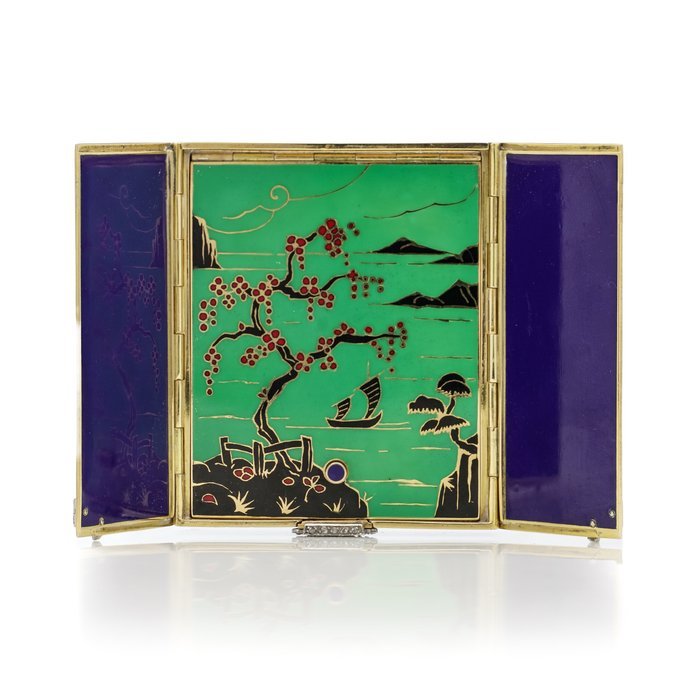The Lacloche Legacy: A Journey Through Time in the World of Jewellery
Lacloche Frères Art Deco Period 18kt Gold and Enamel Powder Compact case with rose-cut diamonds.
This piece was meticulously crafted in France, Paris, dating back to 1935.
It bears the maker's mark for Lacloche Frères and French assay marks
with French export metal mark and the maker's mark for Strauss Allard Meyer.
Image courtesy of Mozeris Fine Antiques
The Lacloche Legacy Emerges: Early Years and Global Ventures
In the annals of jewellery history, the Lacloche family's tale unfolds with the passing of their street-vending patriarch Hendricks Lacloche at the tender age of 42, left behind was a widow, tasked with caring for six children — Leopold, Fernand, Jules, Jacques, Emily, and Berta. Undaunted by adversity, the resilient matriarch urged her offspring to pursue individual dreams in various corners of the globe. The family's entrepreneurial journey took root in 1892, initially spanning Belgium and Spain. By 1895, the Lacloches had acquired drawings bearing the prestigious Lalique signature, marking a significant step in their ascent.
Dreams Fueled by Determination
The Lacloche brothers, Leopold (1863-1921) and Jules (1867-1937), embarked on a remarkable journey in the world of jewellery, overcoming the absence of a prestigious family legacy. Determined to make a name for themselves, the brothers tirelessly pursued their dreams. They established themselves as jewellers in Paris around 1892, initially at 47 rue de Chateaudun, later moving to 41 avenue de l’Opera in 1896.
Expanding Horizons and a Royal Connection
Fernand Lacloche (1868-1931) joined his brothers in Paris after tragedy struck in 1900, as Jacques, one of the Lacloche brothers, died in a train accident, leaving behind a pregnant wife. In the face of adversity, resilience prevailed, and eight months later, Jacques Junior was born, carrying the weight of his father's name. At the age of 18, he seamlessly transitioned into the family business, apprenticing under his uncles and marking the next chapter in the enduring saga of the Lacloche dynasty.
Famous Clients and Unique Creations: Lacloche's Enduring Impact
The Westminster Halo Tiara was the spectacular Art Deco Jewel made by Lacloche from Queen Charlotte’s Arcot Diamonds for Loelia Ponsonby, Duchess of Westminster, image courtesy of The Royal Watcher
The Lacloche brand boasted an illustrious clientele, including Queen Alexandra, the Second Duke and Duchess of Westminster, and the legendary opera singer Caruso. From chokers during the Garland style era to crafting a tiara with Arcot diamonds for Russian-inspired aristocracy, Lacloche's creations adorned the elite.
the early 1920’s: Lacloche's Emergence in the World of Luxury
Lacloche Frères - Bracelet in platinum, diamonds, image courtesy of The French Jewelry Post by Sandrine Merle
In a strategic move that would forever alter the trajectory of Lacloche's storied journey, the acquisition of Fabergé's premises in 1920’s marked a pivotal moment in their history. The purchase not only symbolized a significant expansion of their business but also served as an infusion of inspiration from one iconic brand to another. Fabergé, renowned for its exquisite craftsmanship and imperial clientele, became a wellspring of creative influence for Lacloche. The heritage-rich premises, once graced by the legendary Fabergé creations, provided an immersive environment that fueled Lacloche's artistic aspirations. Drawing from Fabergé's legacy, Lacloche seamlessly integrated the essence of opulence and meticulous craftsmanship into their designs, synthesizing two distinguished artistic traditions that would resonate throughout the ages.
A Triumph at the Exposition Internationale of 1925
An Art Deco enamel, diamond, cultured pearl and 18k gold lipstick case, Lacloche Frères, circa 1925, image courtesy of Alain.R.Truong
The turning point for Maison Lacloche occurred at the Exposition Internationale of 1925, where they stood out among 4000 participants. Only 30 were granted the privilege to exhibit, and Lacloche proudly showcased around 100 items, including 22 clocks and 63 jewels. Collaborating with workshops like Strauss–Allard–Meyer and Rubel, along with designers Georges Verger and Dumont, Lacloche presented a vibrant and sophisticated ensemble that captivated the audience.
Inspirations and Innovations: Lacloche's Design Evolution
Drawing inspiration from Chinese and Oriental art, the discovery of Tutankhamun's tomb, Faberge's works, and the fables of La Fontaine, Lacloche embraced figurative designs. Recurring motifs such as baskets and bouquets of flowers, reminiscent of the tutti frutti style, showcased their artistic prowess. The Musee Galliera exhibition in 1929 highlighted Lacloche's innovative use of stylized drapery, featuring a white pendant in platinum and diamonds. As the 1930s unfolded, Lacloche ventured into novel territories, introducing the cuff bracelet and incorporating baguette fancy brilliant cut diamonds.
The Cuff Bracelet Phenomenon and Beyond
Novelty in Design: Lacloche's Cuff Bracelet
Cuff bracelet in platinum with brilliant - cut and baguette cut diamonds.
Image courtesy of ‘‘ Art Deco jewellery : modernist masterworks and their makers ‘‘
Around 1930, Lacloche introduced the cuff bracelet, a hallmark of this era. This substantial piece, comparable to Mauboussin's Le Rubis exhibition in 1930, marked a significant stride in Lacloche's production line. The bracelet's impressive size and intricate design set it apart, showcasing the company's commitment to innovation and style. The emergence of baguette fancy brilliant cut diamonds during this period further enriched Lacloche's repertoire.
Structural Elegance: Lacloche's Buckle Motif
One of Lacloche's standout designs was a highly structured bracelet consisting of four parallel bands adorned with a buckle motif and rows of pave-set diamonds. The buckles, arranged in a staggered pattern, created a visual twist around the wrist. Each buckle was intricately joined to its strap by a pave-set strip of diamonds baguettes, showcasing the brand's commitment to both structure and aesthetics.
Nancy Cunard's Influence: A Wealthy Trendsetter
Notably, Lacloche's impact extended beyond exhibitions and into the world of fashion. The affluent Nancy Cunard, inspired by Lacloche's creations, embraced a trend of wearing multiple bangles simultaneously. This not only reflected the versatility of Lacloche's designs but also underscored the brand's influence on the fashion choices of the elite.
The Lacloche satoir Kay Francis wore in Girls About Town, was shortened by an unknown jeweller to make a pair of earrings, and an open work diamond - bell-shaped pendant was added.
Image courtesy of K.Sina
Artistic Versatility: Lacloche's Cinematic and Cultural Affinities
Lacloche's cinematic nod with "Girls About Town" underscored the brand's ability to draw inspiration from diverse cultural sources. This dynamic approach not only reflected the zeitgeist but also ensured that Lacloche's designs were a mirror to the ever-evolving tastes of society. The intersection of art, film, and fashion became a defining feature of the Lacloche legacy.
Jacques Lacloche's Journey from jewellery to Contemporary art
In 1931, Jacques Lacloche Junior made a significant move by reestablishing the family legacy in Cannes. However, it was in 1936 that he truly transformed the course of Maison Lacloche's history. During this pivotal year, he initiated a dynamic promotional campaign and marked a strategic shift in the choice of materials. Transitioning from platinum to yellow gold, Jacques Lacloche Junior astutely adapted to the evolving preferences of the clientele. Recognizing the changing demands of the era, he steered the design aesthetics towards pieces that seamlessly integrated into the daily lives and wardrobes of the ladies. The jewellery underwent a notable transformation, embracing a chunkier style adorned with a variety of gemstones, yet delicately preserving an inherent sense of femininity. This period marked not only a shift in materials but also a keen responsiveness to the evolving tastes and lifestyles of Maison Lacloche's discerning clientele.
A Fragrance of Innovation: Lacloche's Venture into Perfume
Jacques Lacloche Junior perfume N.1, image courtesy of The French Jewellery Post by Sandrine Merle
Jacques Lacloche Junior's innovation extended beyond jewellery, as evidenced by the introduction of the N.1 perfume line. A competitor to Chanel N.5, the perfume bottle, resembling a bell, cleverly tied back to the meaning of Lacloche in French. This olfactory venture, accompanied by strategic displays at prestigious locations like the Carlton Hotel in Cannes, underscored Lacloche's ability to diversify without compromising on the essence of luxury.
Transition into Contemporary Art: Jacques Lacloche Junior's Later Years
In the late 1950s, Jacques Lacloche Junior shifted his focus to contemporary art, establishing an art gallery on the first floor of the family's jewellery shop. Eventually abandoning jewellery in 1966, he founded Les Editions Lacloche, becoming a design editor until 1986.
With Les Editions Lacloche, Jacques Lacloche Junior ventured beyond jewellery, showcasing limited edition objects and furniture. The collaboration with renowned designers and artists, such as Roger Talon, added a new dimension to the Lacloche legacy. Despite the eventual closure in 1986, Les Editions Lacloche marked a chapter where art and design seamlessly converged.
An Everlasting Overture: Lacloche's Undying Impact
In concluding the symphony of Lacloche's journey, one cannot overlook the enduring impact of a family that seamlessly blended tradition with innovation. From the intricacies of necessaire art to the avant-garde allure of Les Editions Lacloche, the Lacloche name remains an everlasting overture in the grand opera of artistic expression. Their legacy, defined by resilience, adaptation, and an unwavering commitment to beauty, echoes through the halls of history, inviting generations to immerse themselves in the timeless allure of Lacloche.








